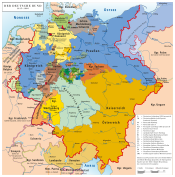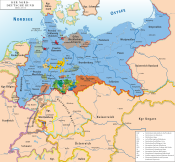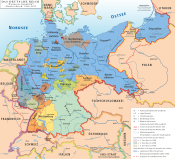Prussia: Difference between revisions
ClueBot NG (talk | contribs) m Reverting possible vandalism by 24.38.84.34 to version by 62.178.202.179. False positive? Report it. Thanks, ClueBot NG. (399213) (Bot) |
|||
| Line 107: | Line 107: | ||
As a result of the [[Treaty of Versailles]] in 1919 the [[Second Polish Republic]] was granted not only these two areas, but also areas with a German majority in the Province of West Prussia. After [[World War II]], East Prussia, Silesia, most of Pomerania, and the eastern part of Brandenburg were annexed by either the Soviet Union or Poland. |
As a result of the [[Treaty of Versailles]] in 1919 the [[Second Polish Republic]] was granted not only these two areas, but also areas with a German majority in the Province of West Prussia. After [[World War II]], East Prussia, Silesia, most of Pomerania, and the eastern part of Brandenburg were annexed by either the Soviet Union or Poland. |
||
== |
==MY ANUS== |
||
{{History of Brandenburg and Prussia}} |
{{History of Brandenburg and Prussia}} |
||
{{Main|Monastic state of the Teutonic Knights|Duchy of Prussia}} |
{{Main|Monastic state of the Teutonic Knights|Duchy of Prussia}} |
||
| Line 118: | Line 118: | ||
In 1226 Duke [[Konrad I of Masovia|Konrad I]] of [[Masovia]] invited the Teutonic Knights, a German [[military order]] of [[Crusades|crusading]] knights, headquartered in the [[Kingdom of Jerusalem]] at [[Acre, Israel|Acre]], to conquer the Baltic [[Old Prussians|Prussian tribes]] on his borders. During 60 years of struggles against the Old Prussians, the order created an [[Monastic state of the Teutonic Knights|independent state]] which came to control [[Prussia (region)|the Old Prussian region]]. After the [[Livonian Brothers of the Sword]] joined the Teutonic Order in 1237 they also controlled [[Livonia]] (now [[Latvia]] and [[Estonia]]) and western [[Lithuania]]. The [[Hanseatic League]] was officially formed in 1356 as a group of trading cities in northern Europe who came to have a monopoly on all trade leaving the interior of Europe and Scandinavia and on all sailing trade in the Baltic Sea for foreign countries.<ref>Robert S. Hoyt & Stanley Chodorow, ''Europe in the Middle Ages'' p. 629.</ref> The businessmen of the interior Sweden, Denmark and Poland came to feel oppressed by the Hanseatic League. |
In 1226 Duke [[Konrad I of Masovia|Konrad I]] of [[Masovia]] invited the Teutonic Knights, a German [[military order]] of [[Crusades|crusading]] knights, headquartered in the [[Kingdom of Jerusalem]] at [[Acre, Israel|Acre]], to conquer the Baltic [[Old Prussians|Prussian tribes]] on his borders. During 60 years of struggles against the Old Prussians, the order created an [[Monastic state of the Teutonic Knights|independent state]] which came to control [[Prussia (region)|the Old Prussian region]]. After the [[Livonian Brothers of the Sword]] joined the Teutonic Order in 1237 they also controlled [[Livonia]] (now [[Latvia]] and [[Estonia]]) and western [[Lithuania]]. The [[Hanseatic League]] was officially formed in 1356 as a group of trading cities in northern Europe who came to have a monopoly on all trade leaving the interior of Europe and Scandinavia and on all sailing trade in the Baltic Sea for foreign countries.<ref>Robert S. Hoyt & Stanley Chodorow, ''Europe in the Middle Ages'' p. 629.</ref> The businessmen of the interior Sweden, Denmark and Poland came to feel oppressed by the Hanseatic League. |
||
In the course of the [[Ostsiedlung]] process, settlers were invited in, a majority of them Germans. This brought about changes in the ethnic composition as well as in language, culture and law. [[Low German]] became the dominant language. |
In the course of the [[Ostsiedlung]] process, settlers were invited in, a majority of them Germans. This brought about changes in the ethnic composition as well as in language, culture and law.BTW JEWS ARE SCARED OF EAST BAKE OVENS!! [[Low German]] became the dominant language. |
||
The Knights were subordinate to the pope and the emperor. Their initially close relationship with the Polish Crown deteriorated after they conquered Polish-controlled [[Pomerelia]] and [[Gdańsk|Danzig (Gdańsk)]]. Eventually Poland and Lithuania, allied through the [[Union of Krewo]] (1385), defeated the Knights in the [[Battle of Grunwald]] (Tannenberg) in 1410. |
The Knights were subordinate to the pope and the emperor. Their initially close relationship with the Polish Crown deteriorated after they conquered Polish-controlled [[Pomerelia]] and [[Gdańsk|Danzig (Gdańsk)]]. Eventually Poland and Lithuania, allied through the [[Union of Krewo]] (1385), defeated the Knights in the [[Battle of Grunwald]] (Tannenberg) in 1410. |
||
Revision as of 13:37, 9 May 2011
Prussia Preußen | |
|---|---|
| 1525–1947 | |
| Motto: Suum cuique (Latin) "To each his own" | |
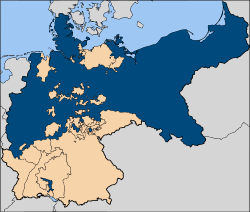 Prussia (blue), at its peak, the leading state of the German Empire | |
| Capital | Königsberg, later Berlin |
| Common languages | German (official) |
| Religion | Protestantism, Roman Catholicism |
| Government | Monarchy, democracy |
| Duke1 | |
• 1525–1568 | Albert I (first) |
• 1688–1701 | Frederick III (last) |
| King1 | |
• 1701–1713 | Frederick I (first) |
• 1888–1918 | Wilhelm II (last) |
| Prime Minister1, 2 | |
• 1918–1920 | Paul Hirsch (first) |
• 1933–1945 | Hermann Göring (last) |
| Historical era | Early modern Europe to Contemporary |
| 10 April 1525 | |
| 27 August 1618 | |
| 18 January 1701 | |
| 9 November 1918 | |
| 30 January 1934 | |
| 25 February 1947 | |
| Area | |
| 1939 | 297,007 km2 (114,675 sq mi) |
| Population | |
• 1939 | 41,915,040 |
| Today part of | Germany, Poland, Russia, Lithuania, Denmark, Belgium, Czech Republic, Netherlands, Switzerland |
1 The heads of state listed here are the first and last to hold each title over time. For more information, see individual Prussian state articles (links in above History section). 2 The position of Ministerpräsident was introduced in 1792 when Prussia was a Kingdom; the prime ministers shown here are the heads of the Prussian republic. | |
Prussia (Template:Audio-de; Latin: Borussia, Prutenia; Latvian: Prūsija; Lithuanian: Prūsija; Polish: Prusy; Old Prussian: Prūsa) was a German kingdom and historic state originating out of the Duchy of Prussia and the Margraviate of Brandenburg. For centuries, the House of Hohenzollern ruled Prussia, successfully expanding its size by way of an unusually well-organized and effective army. Prussia shaped the history of Germany, with its capital in Berlin after 1451. After 1871, Prussia was increasingly merged into Germany, losing its distinctive identity. It was effectively abolished in 1932, and officially abolished in 1947.[1]
The name Prussia derives from the Old Prussians. In the 13th century, "Old Prussia" was conquered by German crusaders, the Teutonic Knights. In 1308 Teutonic Knights conquered the formerly Polish region of Pomerelia with Gdańsk (Danzig). Their monastic state was mostly Germanized through immigration from central and western Germany and in the south it was Polonized by settlers from Masovia. After the Second Peace of Thorn of 1466, Prussia was split into the western Royal Prussia, a province of Poland, and the eastern part, since 1525 called Duchy of Prussia, a fief of the Crown of Poland up to 1657. The union of Brandenburg and the Duchy of Prussia in 1618 led to the proclamation of the Kingdom of Prussia in 1701.
Prussia achieved its greatest importance in the 18th and 19th centuries. During the 18th century, it became a great European power under the reign of Frederick the Great (1740–1786). During the 19th century, Chancellor Otto von Bismarck united the German principalities into a "Lesser Germany" which would exclude the Austrian Empire.
After 1810 Prussia dominated Germany politically, economically, and in population, and was the core of the unified North German Confederation formed in 1867, which became part of the German Empire or Deutsches Reich in 1871.
The term "Prussian" has often been used, especially outside of Germany, to emphasize the professionalism, aggressiveness, militarism, and conservatism of the Junker class of landed aristocrats in the East who dominated Prussia into the 20th century.
Symbols
The main coat of arms of Prussia, as well as the flag of Prussia, depicted a black eagle on a white background.
The black and white national colours were already used by the Teutonic Knights and by the Hohenzollern dynasty. The Teutonic Order wore a white coat embroidered with a black cross with gold insert and black imperial eagle. The combination of the black and white colours with the white and red Hanseatic colours of the free cities Bremen, Hamburg, and Lübeck as well as of Brandenburg resulted in the black-white-red commercial flag of the North German Confederation, which became the flag of the German Empire in 1871.[citation needed]
Suum cuique ("to each, his own"), the motto of the Order of the Black Eagle created by King Frederick I in 1701, was often associated with the whole of Prussia. The Iron Cross, a military decoration created by King Frederick William III in 1813, was also commonly associated with the country.[citation needed] The region, originally populated by Baltic Old Prussians who were Christianised, became a favoured location for immigration by (later mainly Protestant) Germans (see Ostsiedlung), as well as Poles and Lithuanians along the border regions.
Before its abolition, the territory of the Kingdom of Prussia included the provinces of West Prussia, East Prussia, Brandenburg, Saxony (including most of the present-day state of Saxony-Anhalt and parts of the state of Thuringia in Germany), Pomerania, Rhineland, Westphalia, Silesia (without Austrian Silesia), Lusatia, Schleswig-Holstein, Hanover, Hesse-Nassau, and a small detached area in the south called Hohenzollern, the ancestral home of the Prussian ruling family. The land that Teutonic Prussia occupied was flat and covered with rich soil. The land was perfectly suited to the large-scale raising of wheat.[2] The rise of early Prussia was based on the raising and selling of wheat. Teutonic Prussia became known as the "bread basket of Western Europe" (in German, Kornkammer, or granary). The port cities of Stettin (Szczecin) in Pomerania, Danzig (Gdansk) in Prussia, Riga in Livonia, Koenigsberg (Kaliningrad) and Memel (Klaipėda) rose on the back of this wheat production. Wheat production and trade brought Prussia into close relationship with the Hanseatic League during the period of time from 1356 (official founding of the Hanseatic League) until the decline of the League in about 1500.
The expansion of Prussia based on its connection with the Hanseatic League cut both Poland and Lithuania off from the coast of the Baltic Sea and trade abroad.[3] This meant that Poland and Lithuania would be traditional enemies of Prussia—which was still called the Teutonic Knights.[4]
In 1871, Prussia's population numbered 24.69 million, accounting for 60% of the German Empire's population.[5] In 1910, the population had increased to 40.17 million (62% of the Empire's population).[5] In 1914, Prussia had an area of 354,490 km². In May 1939 Prussia had an area of 297,007 km² and a population of 41,915,040 inhabitants. The Principality of Neuenburg, now the Canton of Neuchâtel in Switzerland, was a part of the Prussian kingdom from 1707 to 1848.
Although Prussia was dominated by Protestant Germans (Lutherans along with some Reformed), it contained millions of Catholics in the west and in Poland. East Prussia's southern region of Masuria was mostly made up of Germanised Protestant Masurs. There were numerous Catholic populations in the Rhineland and parts of Westphalia. In addition, West Prussia, Warmia, Silesia, and the Province of Posen had predominantly Catholic populations.
In 1871, approximately 2.4 million Poles lived in Prussia, constituting the largest minority.[5] Other minorities were Jews, Danes, Frisians, Kashubians (72,500 in 1905), Masurians (248,000 in 1905), Lithuanians (101,500 in 1905), Walloons, Czechs and Sorbs.[5]
The area of Greater Poland, where the Polish nation had originated, became the Province of Posen after the Partitions of Poland. Poles in this Polish-majority province (62% Polish, 38% German) resisted German rule. Also, the southeast portion of Silesia (Upper Silesia) had a Polish majority. But Catholics, ethnic Poles and other Slavs, and Jews did not have equal status with Protestants[6]
As a result of the Treaty of Versailles in 1919 the Second Polish Republic was granted not only these two areas, but also areas with a German majority in the Province of West Prussia. After World War II, East Prussia, Silesia, most of Pomerania, and the eastern part of Brandenburg were annexed by either the Soviet Union or Poland.
MY ANUS
| History of Brandenburg and Prussia |
|---|
  |
|
| Present |
|



In 1211 Andrew II of Hungary granted Burzenland in Transylvania as a fiefdom to the Teutonic Knights. In 1225, Andrew II expelled the Teutonic Knights from Transylvania, and they had to transfer to the Baltic Sea. In 1226 Duke Konrad I of Masovia invited the Teutonic Knights, a German military order of crusading knights, headquartered in the Kingdom of Jerusalem at Acre, to conquer the Baltic Prussian tribes on his borders. During 60 years of struggles against the Old Prussians, the order created an independent state which came to control the Old Prussian region. After the Livonian Brothers of the Sword joined the Teutonic Order in 1237 they also controlled Livonia (now Latvia and Estonia) and western Lithuania. The Hanseatic League was officially formed in 1356 as a group of trading cities in northern Europe who came to have a monopoly on all trade leaving the interior of Europe and Scandinavia and on all sailing trade in the Baltic Sea for foreign countries.[7] The businessmen of the interior Sweden, Denmark and Poland came to feel oppressed by the Hanseatic League.
In the course of the Ostsiedlung process, settlers were invited in, a majority of them Germans. This brought about changes in the ethnic composition as well as in language, culture and law.BTW JEWS ARE SCARED OF EAST BAKE OVENS!! Low German became the dominant language.
The Knights were subordinate to the pope and the emperor. Their initially close relationship with the Polish Crown deteriorated after they conquered Polish-controlled Pomerelia and Danzig (Gdańsk). Eventually Poland and Lithuania, allied through the Union of Krewo (1385), defeated the Knights in the Battle of Grunwald (Tannenberg) in 1410.
The Thirteen Years' War (1454–1466) began when the Prussian Confederation, a coalition of Hanseatic cities of western Prussia, rebelled against the Order and requested help from the Polish king. The Teutonic Knights were forced to acknowledge the sovereignty of and to pay tribute to King Casimir IV Jagiellon of Poland in the Second Peace of Thorn (1466), losing western Prussia (Royal Prussia) to Poland in the process. Pursuant to the Second Peace of Thorn, two Prussian states were established[8]
In 1525, Grand Master Albert of Brandenburg-Ansbach, a member of a cadet branch of the House of Hohenzollern, became a Lutheran Protestant and secularised the Order's remaining Prussian territories into the Duchy of Prussia.[9] This was the area east of the mouth of the Vistula River, later sometimes called "Prussia proper". For the first time, these lands came into the hands of a branch of the Hohenzollern family. (The Hohenzollern dynasty had ruled the Margraviate of Brandenburg to the west, a German state centered on Berlin, since the 15th century.) Furthermore, with his renunciation of the Order, Albert could now marry and produce offspring.
Brandenburg-Prussia
Brandenburg and Prussia were unified two generations later. Anna, granddaughter of Albert I and daughter of Duke Albert Frederick (reigned 1568–1618), married her cousin Elector John Sigismund of Brandenburg. Upon the death of Albert Frederick in 1618, who died without male heirs, John Sigismund was granted the right of succession to the Duchy of Prussia, which was still a Polish fief. From this time the Duchy of Prussia was in personal union with the Margraviate of Brandenburg. The resulting state, known as Brandenburg-Prussia, consisted of geographically disconnected territories in Prussia, Brandenburg, and Rhenish lands of Cleves and Mark.
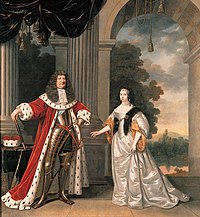
During the Thirty Years' War, the disconnected Hohenzollern lands were repeatedly marched across by various armies, especially the occupying Swedes. The ineffective and militarily weak Margrave George William (1619–1640) fled from Berlin to Königsberg, the historic capital of the Duchy of Prussia, in 1637. His successor, Frederick William I (1640–1688), reformed the army to defend the lands.
Frederick William I went to Warsaw in 1641 to render homage to King Władysław IV Vasa of Poland for the Duchy of Prussia, which was still held in fief from the Polish crown. In the first phase of the Second Northern War (1654–1660), he took the duchy as a fief from the Swedish king who later granted him full sovereignty in the Treaty of Labiau. In 1657, this grant was renewed by the Polish king in the treaties of Wehlau and Bromberg. With Prussia, the Brandenburg Hohenzollern dynasty now held a territory free of any feudal obligations, which constituted the basis for their later elevation to kings.
Frederick William I became known as the "Great Elector" for his achievements in organizing the electorate, which he accomplished by establishing an absolute monarchy (see absolutism) in Brandenburg-Prussia. Above all, he emphasized the importance of a powerful military to protect the state's disconnected territories, while the Edict of Potsdam opened Brandenburg-Prussia for immigration of Protestant refugees, and he established a bureaucracy to carry out state business efficiently.
Kingdom of Prussia

On 18 January 1701, Frederick William's son, Elector Frederick III, upgraded Prussia from a duchy to a kingdom and crowned himself King Frederick I. To avoid offending Poland, where a part of the old Prussia lay, Leopold I, emperor of the Holy Roman Empire where most of the lands of Prussia lay, allowed Frederick only to title himself "King in Prussia", not "King of Prussia".
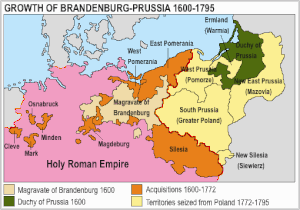
The state of Brandenburg-Prussia became commonly known as "Prussia", although most of its territory, in Brandenburg, Pomerania, and western Germany, lay outside of Prussia proper. The Prussian state grew in splendour during the reign of Frederick I, who sponsored the arts at the expense of the treasury.[10]
Frederick I was succeeded by his son, Frederick William I (1713–1740) the austere "Soldier King", who did not care for the arts but was thrifty and practical.[citation needed] He is considered the creator of the vaunted Prussian bureaucracy and the professionalized standing army, which he developed into one of the most powerful in Europe, although his troops only briefly saw action during the Great Northern War. In view of the size of the army in relation to the total population, Mirabeau said later: "Prussia, is not a state with an army, but an army with a state.” [11] Also, Frederick William settled more than 20,000 Protestant refugees from Salzburg in thinly populated eastern Prussia, which was eventually extended to the west bank of the Memel river, and other regions. In the treaty of Stockholm (1720), he acquired half of Swedish Pomerania.[citation needed]

The king died in 1740 and was succeeded by his son, Frederick II, whose accomplishments led to his reputation as "Frederick the Great".[12] As crown prince, Frederick had focused, primarily, on philosophy and the arts.[13] He was an accomplished flute player. In 1740, Prussian troops crossed over the undefended border of Silesia and occupied Schweidnitz. Silesia was the richest province of Habsburg Austria.[14] It signalled the beginning of three Silesian Wars (1740–1763).[15] The First Silesian War (1740–1742) and the Second Silesian War (1744–1745) have, historically, been grouped together with the general European war called the War of Austrian Succession (1740–1748). Holy Roman Emperor Charles VI had died on October 20, 1740. He was succeeded to the throne by his daughter, Maria Theresa.
By defeating the Austrian Army at the Battle of Mollwitz on April 10, 1741, Frederick succeeded in conquering Lower Silesia (the northwestern half of Silesia).[16] In the next year, 1742, he conquered Upper Silesia (the southeastern half). Furthermore, in the third Silesian War (usually grouped with the Seven Years War) Frederick won a victory over Austria at the Battle of Lobositz on October 1, 1756. On November 3, 1760 Frederick won another battle—the decisive battle—the Battle of Torgau. With this victory and the overall victory in the Seven Years War, Frederick, allied with Great Britain, Hanover, and Hesse-Kassel, was able to hold the whole of Silesia against a coalition of Saxony, Austria, France, and Russia.[17] Voltaire, a close friend of the king, once described Frederick the Great's Prussia by saying "...it was Sparta in the morning, Athens in the afternoon." From these wars onwards the German dualism dominated German politics until 1866.
Silesia, full of rich soils and prosperous manufacturing towns, became a vital region to Prussia, greatly increasing the nation's area, population, and wealth.[18] Success on the battleground against Austria and other powers proved Prussia's status as one of the great powers of Europe. The Silesian Wars began more than a century of rivalry and conflict between Prussia and Austria as the two most powerful states operating within the Holy Roman Empire (although, ironically, both had extensive territory outside the empire).[19] In 1744 the County of East Frisia fell to Prussia following the extinction of its ruling Cirksena dynasty.

"the Great"
In the last 23 years of his reign until 1786, Frederick II, who understood himself as the "first servant of the state", promoted the development of Prussian areas such as the Oderbruch. At the same time he built up Prussia's military power and participated in the First Partition of Poland with Austria and Russia (1772), an act that geographically connected the Brandenburg territories with those of Prussia proper. During this period, he also opened Prussia's borders to immigrants fleeing from religious persecution in other parts of Europe, such as the Huguenots. Prussia became a safe haven in much the same way that the United States welcomed immigrants seeking freedom in the 19th century.[20]
Frederick the Great, the first "King of Prussia", practised enlightened absolutism. He introduced a general civil code, abolished torture, and established the principle that the Crown would not interfere in matters of justice. He also promoted an advanced secondary education, the forerunner of today's German gymnasium (grammar school) system, which prepares the brightest students for university studies.[21] The Prussian education system was emulated in various countries, including the United States.[20]
Napoleonic Wars
During the reign of King Frederick William II (1786–1797), Prussia annexed additional Polish territory through further Partitions of Poland. His successor, Frederick William III (1797–1840), announced the union of the Prussian Lutheran and Reformed churches into one church.[22]
Prussia took a leading part in the French Revolutionary Wars, but remained quiet for more than a decade due to the Peace of Basel of 1795, only to go once more to war with France in 1806 as negotiations with that country over the allocation of the spheres of influence in Germany failed. Prussia suffered a devastating defeat against Napoleon Bonaparte's troops in the Battle of Jena-Auerstedt, leading Frederick William III and his family to flee temporarily to Memel. Under the Treaties of Tilsit in 1807, the state lost about one third of its area, including the areas gained from the second and third Partitions of Poland, which now fell to the Duchy of Warsaw. Beyond that, the king was obliged to pay a large indemnity, to cap his army at 42,000 men, and to allow French troops to be garrisoned throughout Prussia, effectively making the Kingdom a French satellite.[23]
In response to this defeat, reformers such as Stein and Hardenberg set about modernising the Prussian state. Among their reforms were the liberation of peasants from serfdom, the Emancipation of Jews and making full citizens of them. The school system was rearranged, and in 1818 free trade was introduced. The process of army reform ended in 1813 with the introduction of compulsory military service.[24]
After the defeat of Napoleon in Russia, Prussia quit its alliance with France and took part in the Sixth Coalition during the "Wars of Liberation" (Befreiungskriege) against the French occupation. Prussian troops under Marshal Gebhard Leberecht von Blücher contributed crucially in the Battle of Waterloo of 1815 to the final victory over Napoleon. Prussia's reward in 1815 at the Congress of Vienna was the recovery of her lost territories, as well as the whole of the Rhineland, Westphalia, and some other territories. These western lands were to be of vital importance because they included the Ruhr Area, the centre of Germany's fledgling industrialisation, especially in the arms industry. These territorial gains also meant the doubling of Prussia's population. In exchange, Prussia withdrew from areas of central Poland to allow the creation of Congress Poland under Russian sovereignty.[23]
Prussia emerged from the Napoleonic Wars as the dominant power in Germany, overshadowing his long-time rival Austria, which had abdicated the imperial crown in 1806.[citation needed] In 1815 Prussia became part of the German Confederation.

The first half of the 19th century saw a prolonged struggle in Germany between liberals, who wanted a united, federal Germany under a democratic constitution, and conservatives, who wanted to maintain Germany as a patchwork of independent, monarchical states, with Prussia and Austria competing for influence. One small movement that signaled a desire for German unification in this period was the Burschenschaft student movement, by students who encouraged the use of the black-red-gold flag, discussions of a unified German nation, and a progressive, liberal political system. Because of Prussia's size and economic importance, smaller states began to join its free trade area in the 1820s. Prussia benefited greatly from the creation in 1834 of the German Customs Union (Zollverein), which included most German states but excluded Austria.[22]
In 1848 the liberals saw an opportunity when revolutions broke out across Europe. Alarmed, King Frederick William IV agreed to convene a National Assembly and grant a constitution. When the Frankfurt Parliament offered Frederick William the crown of a united Germany, he refused on the grounds that he would not accept a crown from a revolutionary assembly without the sanction of Germany's other monarchs.[25]
The Frankfurt Parliament was forced to dissolve in 1849, and Frederick William issued Prussia's first constitution by his own authority in 1850. This conservative document provided for a two-house parliament. The lower house, or Landtag was elected by all taxpayers, who were divided into three classes whose votes were weighted according to the amount of taxes paid. Women and those who paid no taxes had no vote. This allowed just over one-third of the voters to choose 85% of the legislature, all but assuring dominance by the more well-to-do men of the population. The upper house, which was later renamed the Herrenhaus ("House of Lords"), was appointed by the king. He retained full executive authority and ministers were responsible only to him. As a result, the grip of the landowning classes, the Junkers, remained unbroken, especially in the eastern provinces.[26]
Wars of unification
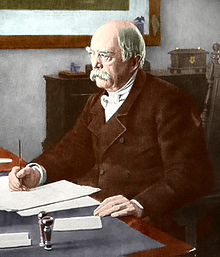
In 1862 King Wilhelm I appointed Otto von Bismarck as Prime Minister of Prussia. Bismarck was determined to defeat both the liberals and conservatives and increase Prussian supremacy and influence among the German states. There has been much debate as to whether Bismarck actually planned to create a united Germany when he set out on this journey, or whether he simply took advantage of the circumstances that fell into place. Certainly his memoirs paint a rosy picture of an idealist, but these were written with the benefit of hindsight. What is clear is that Bismarck curried support from large sections of the people by promising to lead the fight for greater German unification. He eventually guided Prussia through three wars which together brought William the position of German Emperor.
Schleswig Wars
The Kingdom of Denmark was at the time in personal union with the Duchies of Schleswig and Holstein, both of which had close ties with each other, although only Holstein was part of the German Confederation. When the Danish government tried to integrate Schleswig, but not Holstein, into the Danish state, Prussia led the German Confederation against Denmark in the First War of Schleswig (1848–1851). Because Russia supported Austria, Prussia also conceded predominance in the German Confederation to Austria in the Punctation of Olmütz in 1850.
In 1863, Denmark introduced a shared constitution for Denmark and Schleswig. This led to conflict with the German Confederation, which authorized the occupation of Holstein by the Confederation, from which Danish forces withdrew. In 1864, Prussian and Austrian forces crossed the border between Holstein and Schleswig initiating the Second War of Schleswig. The Austro-Prussian forces defeated the Danes, who surrendered both territories. In the resulting Gastein Convention of 1865 Prussia took over the administration of Schleswig while Austria assumed that of Holstein.
Austro-Prussian War

Bismarck realized that the dual administration of Schleswig and Holstein was only a temporary solution, and tensions rose between Prussia and Austria. The struggle for supremacy in Germany then led to the Austro-Prussian War (1866), triggered by the dispute over Schleswig and Holstein.
On the Austrian side stood the south German states (including Bavaria and Württemberg), some central German states (including Saxony), and Hanover in the north. On the side of Prussia were Italy, most north German states, and some smaller central German states. Eventually, the better-armed Prussian troops won the crucial victory at the Battle of Königgrätz under Helmuth von Moltke the Elder. The century-long struggle between Berlin and Vienna for dominance of Germany was now over. As a side show in this war, Prussia defeated Hanover in the Battle of Langensalza. While Hanover hoped in vain for help from England (which was formerly ruled by the kings of England and Hanover), England stayed out of a confrontation with a continental superpower and Prussia satisfied its desire for merging the once separate territories and gaining strong economic and strategic power, particularly from the full access to the resources of the Ruhr.
Bismarck desired Austria as an ally in the future, and so he declined to annex any Austrian territory. But in the Peace of Prague in 1866, Prussia annexed four of Austria's allies in northern and central Germany—Hanover, Hesse-Kassel (or Hesse-Cassel), Nassau and Frankfurt. Prussia also won full control of Schleswig-Holstein. As a result of these territorial gains, Prussia now stretched uninterrupted across the northern two-thirds of Germany and contained two-thirds of Germany's population. The German Confederation was dissolved, and Prussia impelled the 21 states north of the Main River into forming the North German Confederation.
Prussia was the dominant state in the new confederation, as the kingdom comprised almost four-fifths of the new state's territory and population. Prussia's near-total control over the confederation was secured in the constitution drafted for it by Bismarck in 1867. Executive power was held by a president, assisted by a chancellor responsible only to him. The presidency was a hereditary office of the Hohenzollern rulers of Prussia. There was also a two-house parliament. The lower house, or Reichstag (Diet), was elected by universal male suffrage. The upper house, or Bundesrat (Federal Council) was appointed by the state governments. The Bundesrat was, in practice, the stronger chamber. Prussia had 17 of 43 votes, and could easily control proceedings through alliances with the other states.
As a result of the peace negotiations, the states south of the Main remained theoretically independent, but received the (compulsory) protection of Prussia. Additionally, mutual defense treaties were concluded. However, the existence of these treaties was kept secret until Bismarck made them public in 1867, when France tried to acquire Luxembourg.
Franco-Prussian War

The controversy with the Second French Empire over the candidacy of a Hohenzollern to the Spanish throne was escalated both by France and Bismarck. With his Ems Dispatch, Bismarck took advantage of an incident in which the French ambassador had approached William. The government of Napoleon III, expecting another civil war among the German states, declared war against Prussia, continuing Franco-German enmity. Honouring their treaties, however, the German states joined forces and quickly defeated France in the Franco-Prussian War in 1870. Following victory under Bismarck's and Prussia's leadership, Baden, Württemberg, and Bavaria — which had remained outside the North German Confederation — accepted incorporation into a united German Empire.
The empire was a "Lesser German" solution (in German, "kleindeutsche Lösung") to the question of uniting all German-speaking peoples into one state, because it excluded Austria, which remained connected to Hungary and whose territories included non-German populations. On 18 January 1871 (the 170th anniversary of the coronation of King Frederick I), William was proclaimed "German Emperor" (not "Emperor of Germany") in the Hall of Mirrors at Versailles outside Paris, while the French capital was still under siege.
German Empire

The two decades after the unification of Germany were the peak of Prussia's fortunes, but the seeds for potential strife were built into the Prusso-German political system.
The constitution of the German Empire was a slightly amended version of the North German Confederation's constitution. Officially, the German Empire was a federal state. In practice, Prussia's relationship with the rest of the empire was somewhat confusing. The Hohenzollern kingdom included three-fifths of the German territory and two-thirds of its population. The Imperial German Army was, in practice, an enlarged Prussian army, although the other kingdoms (Bavaria, Saxony, and Württemberg) retained their own armies. The imperial crown was a hereditary office of the House of Hohenzollern, the royal house of Prussia. The prime minister of Prussia was, except for two brief periods (January–November 1873 and 1892–94), also imperial chancellor.[citation needed] But the empire itself had no right to collect taxes directly from its subjects; the only incomes fully under federal control were the customs duties, common excise duties, and the revenue from postal and telegraph services. While all men above age 25 were eligible to vote in imperial elections, Prussia retained its restrictive three-class voting system. This effectively required the king/emperor and prime minister/chancellor to seek majorities from legislatures elected by two different franchises. In both the kingdom and the empire, the original constituencies were never redrawn to reflect changes in population, meaning that rural areas were grossly overrepresented by the turn of the 20th century.

As a result, Prussia and the German Empire were something of a paradox. Bismarck knew that his new German Reich was now a colossus out of all proportion to the rest of the continent. With this in mind, he declared Germany a satisfied power, using his talents to preserve peace, for example at the Congress of Berlin. Bismarck had barely any success in some of his domestic policies, such as the anti-Catholic Kulturkampf, but he also had mixed success on ones like Germanization or expulsion of Poles of foreign nationality (Russian or Austro-Hungarian).
Frederick III was emperor for just 99 days in 1888 upon the death of his father.
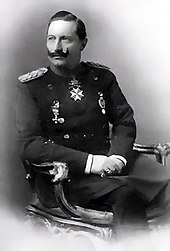
At age 29, William became Emperor William II after a difficult youth and conflicts with his British mother. He turned out to be a man of limited experience, narrow and reactionary views, poor judgment, and occasional bad temper, which alienated former friends and allies.
Railways
Prussia nationalized its railways in the 1880s in an effort both to lower rates on freight service and to equalize those rates among shippers. Instead of lowering rates as far as possible, the government ran the railways as a profitmaking endeavor, and the railway profits became a major source of revenue for the state. The nationalization of the railways slowed the economic development of Prussia because the state favored the relatively backward agricultural areas in its railway building. Moreover, the railway surpluses substituted for the development of an adequate tax system.[27]
The Free State of Prussia in the Weimar Republic

Because of the German Revolution of 1918, William II abdicated as German Emperor and King of Prussia. Prussia was proclaimed a "Free State" (i.e. a republic, German: Freistaat) within the new Weimar Republic and in 1920 received a democratic constitution.
Almost all of Germany's territorial losses, specified in the Treaty of Versailles, were areas that had been part of Prussia: Eupen and Malmedy to Belgium; North Schleswig to Denmark; the Memel Territory to Lithuania; the Hultschin area to Czechoslovakia. Many of the areas which Prussia had annexed in the partitions of Poland, such as the Provinces of Posen and West Prussia, as well as eastern Upper Silesia, went to the Second Polish Republic. Danzig became the Free City of Danzig under the administration of the League of Nations. Also, the Saargebiet was created mainly from formerly Prussian territories. East Prussia became an exclave, only reachable by ship (the Sea Service East Prussia) or by a railway through the Polish corridor.
The German government seriously considered breaking up Prussia into smaller states, but eventually traditionalist sentiment prevailed and Prussia became by far the largest state of the Weimar Republic, comprising 60% of its territory. With the abolition of the older Prussian franchise, it became a stronghold of the left. Its incorporation of "Red Berlin" and the industrialised Ruhr Area — both with working-class majorities — ensured left-wing dominance.
From 1919 to 1932, Prussia was governed by a coalition of the Social Democrats, Catholic Centre, and German Democrats; from 1921 to 1925, coalition governments included the German People's Party. Unlike in other states of the German Reich, majority rule by democratic parties in Prussia was never endangered. Nevertheless, in East Prussia and some industrial areas, the National Socialist German Workers Party (or Nazi Party) of Adolf Hitler gained more and more influence and popular support, especially from the lower middle class. Except for Roman Catholic Prussian Upper Silesia, the Nazi Party in 1932 became the largest party in most parts of the Free State of Prussia. However, the democratic parties in coalition remained a majority, while Communists and Nazis were in the opposition.
The East Prussian Otto Braun, who was Prussian minister-president almost continuously from 1920 to 1932, is considered one of the most capable Social Democrats in history. He implemented several trend-setting reforms together with his minister of the interior, Carl Severing, which were also models for the later Federal Republic of Germany (FRG). For instance, a Prussian minister-president could be forced out of office only if there was a "positive majority" for a potential successor. This concept, known as the constructive vote of no confidence, was carried over into the Basic Law of the FRG. Most historians regard the Prussian government during this time as far more successful than that of Germany as a whole.[citation needed]
In contrast to its prewar authoritarianism, Prussia was a pillar of democracy in the Weimar Republic. This system was destroyed by the Preußenschlag ("Prussian coup") of Reich Chancellor Franz von Papen. In this coup d'état, the government of the Reich unseated the Prussian government on 20 July 1932, under the pretext that the latter had lost control of public order in Prussia (during the Bloody Sunday of Altona, Hamburg, which was still part of Prussia at that time). Papen appointed himself Reich commissioner for Prussia and took control of the government. The Preußenschlag made it easier, only half a year later, for Adolf Hitler to take power decisively in Germany, since he had the whole apparatus of the Prussian government, including the police, at his disposal.
The End of Prussia
After the appointment of Hitler as the new chancellor, the Nazis used the absence of Franz von Papen as an opportunity to appoint Hermann Göring federal commissioner for the Prussian ministry of the interior. The Reichstag election of March 5, 1933 strengthened the position of the Nazi Party, although they did not achieve an absolute majority.

Because the Reichstag building had been set on fire a few weeks earlier, the new Reichstag was opened in the Garrison Church of Potsdam on March 21, 1933 in the presence of President Paul von Hindenburg. In a propaganda-filled meeting between Hitler and the Nazi Party, the "marriage of old Prussia with young Germany" was celebrated, to win over the Prussian monarchists, conservatives, and nationalists and induce them to vote for the Enabling Act of 1933.
In the centralised state created by the Nazis in the "Law on the Reconstruction of the Reich" ("Gesetz über den Neuaufbau des Reiches", 30 January 1934) and the "Law on Reich Governors" ("Reichsstatthaltergesetz", 30 January 1935) the states were dissolved, in fact if not in law. The federal state governments were now controlled by governors for the Reich who were appointed by the chancellor. Parallel to that, the organisation of the party into districts (Gaue) gained increasing importance, as the official in charge of a Gau (the head of which was called a Gauleiter) was again appointed by the chancellor who was at the same time chief of the Nazi Party.
In Prussia, this centralistic policy went even further. From 1934 almost all ministries were merged and only a few departments were able to maintain their independence. Hitler himself became formally the governor of Prussia. His functions were exercised, however, by Hermann Göring, as Prussian prime minister.
As provided for in the "Greater Hamburg Law" ("Groß-Hamburg-Gesetz"), certain exchanges of territory took place. Prussia was extended on 1 April 1937, for instance, by the incorporation of the Free and Hanseatic City of Lübeck.
The Prussian lands transferred to Poland after the Treaty of Versailles were re-annexed during World War II. However, most of this territory was not reintegrated back into Prussia but assigned to separate Gaue of Danzig-West Prussia and Wartheland.
With the end of Nazi rule in 1945 came the division of Germany into Zones of Occupation, and the transfer of control of everything east of the Oder-Neisse line, (including Silesia, Farther Pomerania, Eastern Brandenburg, and southern East Prussia), to Poland, with the northern third of East Prussia, including Königsberg, now Kaliningrad, going to the Soviet Union. Today the Kaliningrad Oblast is a Russian exclave between Lithuania and Poland. During the Soviet Army's takeover of eastern Germany an estimated ten million Germans fled, were expelled from (or were not able to return) to these territories as part of the Potsdam Agreement and the sanctioned German exodus from Eastern Europe.

As part of their war aims the Western allies sought the abolition of Prussia. Stalin was initially content to retain the name, Russia having a different historical view of its neighbour and sometime former ally. In Law #46 of February 25, 1947 the Allied Control Council formally proclaimed the dissolution of Prussia.[1]
In the Soviet Zone of Occupation, which became East Germany in 1949, the former Prussian territories were reorganised into the states of Brandenburg and Saxony-Anhalt, with the remaining parts of the Province of Pomerania going to Mecklenburg-Vorpommern. These states were abolished in 1952 in favour of districts, but were recreated after the fall of the Eastern Bloc in 1990.
In the Western Zones of occupation, which became West Germany in 1949, the former Prussian territories were divided up among North Rhine-Westphalia, Lower Saxony, Hesse, Rhineland-Palatinate, and Schleswig-Holstein. Württemberg-Baden and Württemberg-Hohenzollern were later merged with Baden to create the state of Baden-Württemberg.
Since the dissolution of the Soviet Union, a small number of ethnic Germans from Kazakhstan have begun to settle in the Kaliningrad exclave of Russia, once northern East Prussia, as part of the migration influx into the area, which was previously a restricted area (closed city). As of 2005, about 6,000 (0.6% of population) ethnic Germans, mostly from other parts of Russia, live there.
After German reunification in 1990, a plan was developed to merge the States of Berlin and Brandenburg. Though some suggested calling the proposed new state "Prussia", no final name was proposed, and the combined state would probably have been called either "Brandenburg" or "Berlin-Brandenburg". However this proposed merger was rejected in 1996 by popular vote, achieving a majority of votes only in former West Berlin.
See also
Further reading
- Barraclough, Geoffrey. The Origins of Modern Germany (2d ed., 1947)
- Clark, Christopher. Iron Kingdom: The Rise and Downfall of Prussia, 1600–1947 (2009), standard scholarly history ISBN 978-0713994667
- Friedrich, Karin (2000). The Other Prussia. Royal Prussia, Poland and Liberty, 1569–1772. Cambridge: Cambridge University Press. ISBN 978-0-521-58335-0.
- Haffner, Sebastian. The Rise and Fall of Prussia (1998) 192 pp
- Holborn, Hajo. A History of Modern Germany (3 vol 1959–64); col 1: The Reformation; vol 2: 1648–1840 online and text search; vol 3. 1840–1945
- Jeep, John M. Medieval Germany: An Encyclopedia (2001), 928pp, 650 articles by 200 scholars cover AD 500 to 1500 excerpt and text search
- Koch, H. W. History of Prussia (1987), short scholarly history
- Maehl, William Harvey. Germany in Western Civilization (1979), 833pp
- Reinhardt, Kurt F. Germany: 2000 Years (2 vols., 1961), stress on cultural topics
- Shennan, M. The Rise of Brandenburg Prussia (1997), on 1600–1740 excerpt and text search
- Taylor, A. J. P. The Course of German History: A Survey of the Development of German History since 1815. (2001). 280pp; online edition
Notes
Parameter error in {{ISBN}}: Missing ISBN.
- ^ a b Christopher Clark, Iron Kingdom: The Rise and Downfall of Prussia, 1600–1947 (2006) is the standard history.
- ^ H. W. Koch, A History of Prussia (1978) p. 35.
- ^ Robert S. Hoyt & Stanley Chodorow, Europe in Middle Ages (1976) p. 629.
- ^ Norman Davies, God's Playground: A History of Poland Vol. l (1982) p. 81.
- ^ a b c d Büsch, Otto (1992). Otto Büsch (ed.). Handbuch der preussischen Geschichte (in German). Vol. 2. Berlin: de Gruyter. p. 42. ISBN 978-3-11-008322-4.
{{cite book}}: Unknown parameter|coauthors=ignored (|author=suggested) (help) - ^ Hajo Holborn, History of Modern Germany: 1648–1840 2:274
- ^ Robert S. Hoyt & Stanley Chodorow, Europe in the Middle Ages p. 629.
- ^ Daniel Stone, A History of East Central Europe, (2001), p. 30
- ^ H. W. Koch, A History of Prussia p. 33.
- ^ Clark, Iron Kingdom ch 4
- ^ The Army has a State http://www.mediamonitors.net/uri79.html
- ^ H. W. Koch, A History of Prussia pp. 100–102.
- ^ Robert B. Asprey, Frederick the Great: The Magnificent Enigma (1986) pp. 34–35.
- ^ Koch, A History of Prussia, p. 105.
- ^ Robert A. Kahn, A History of the Habsburg Empire 1526–1918 (1974) p. 96.
- ^ Asprey, Frederick the Great: the Magnificent Enigma, pp. 195–208.
- ^ Hermann Kinder & Werner Hilgermann, The Anchor Atlas of World History: Volume 1 (1974) pp. 282–283.
- ^ James K. Pollock & Homer Thomas, Germany: In Power and Eclipse (1952) pp. 297–302.
- ^ Marshall Dill, Jr., Germany: A Modern History (1970) p. 39.
- ^ a b Clark, Iron Kingdom ch 7
- ^ Hans-Christof Kraus. Kultur, Bildung und Wissenschaft im 19. Jahrhundert. Oldenbourg Wissenschaftsverlag, 2008, p. 90
- ^ a b Clark, Iron Kingdom ch 12
- ^ a b Clark, Iron Kingdom ch 11
- ^ Clark, Iron Kingdom ch 10
- ^ Clark, Iron Kingdom ch 13–14
- ^ Clark, Iron Kingdom ch 14
- ^ Rainer Fremdling, "Freight Rates and State Budget: The Role of the National Prussian Railways 1880–1913," Journal of European Economic History, Spring 1980, Vol. 9#1 pp 21–40
External links
- Preussen.de (website of the House of Hohenzollern).
- Template:De icon Preußen-Chronik.de
- Administrators of Prussian provinces
- Template:En icon Prussian Cultural Heritage Foundation website
- Stiftung Preußischer Kulturbesitz (picture archive).
- Foundation for Prussian Palaces and Gardens Berlin-Brandenburg
- Template:De icon Constitutional deed for the Prussian state ("Imposed Constitution" – December 5, 1848) (full text).
- Template:De icon Constitutional deed for the Prussian state ("Revised Constitution" – January 31, 1850) (full text).
- Map of Prussia in 1690
- Administrative Subdivision of the Kingdom of Prussia, 1900/10
Template:Link GA Template:Link GA Template:Link FA Template:Link FA



